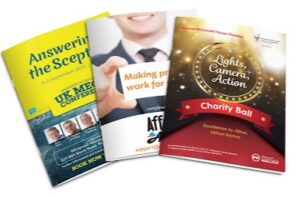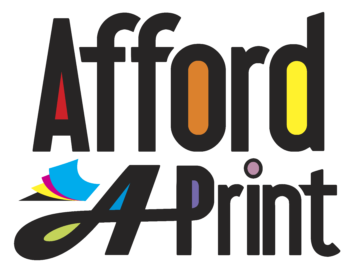Are you planning to print a booklet? Here are some suggestions to help you.
Printing stapled booklets is generally a production of around 14 sheets (56 pages / printed sides) or less. However, we have tackled projects with stapled booklets that had more pages. It is preferable, however, to perfect bind booklets with a large page count, instead of stapling them. Books can have either hard or soft covers, but the cover of a booklet is usually created using the same paper. The weight of the cover paper can be altered depending on the project, ranging from 250gsm light card to a heavier card option.
A heavier gage of paper cover such as 170gsm silk upwards is recommended to provide better protection for the inside pages, depending on the use of your items.
The most frequently used type of binding for booklets is the “Saddle Stitch.” This form of binding booklets is the most economical, and involves two staples.
[presto_player id=1384]
Here are 10 things for you to take into account if you decide to print a booklet
- When constructing a booklet, it is important to keep the page count divisible by four. For example, if you are using A4 paper folded in half (making it A5) then one page would equate to four pages, which is actually a folded flyer. If there are two sheets folded together and needing stapling, this is the smallest option for a stapled booklet. If for example, there were 14 folded sheets, they would would generate a 56-page booklet. If the amount of text is less that you submit to use for printing, such as 55, 54, or 53 pages, the booklet would have to have empty pages.
- It is important to leave space between the text and the page crease when formatting the booklet. Additionally, make sure that there is room on the left and right edges of the page, so the reader can hold both sides without covering the text. We can provide you with a template to give you a better idea of where to place your text.
- When it comes to booklet printing, it is essential to ensure that there is at least a 3mm bleed on any text and cover art that will go to the edge of the page. Bleed is the term used for content that extends beyond the trim edge and does not contain any white margin.
Read more/view our video guide about bleed on this page.
- The cover page should be printed on paper with a weight between 120gsm and 250gsm for a sturdy finish. Glossy, matt or soft touch lamination can be used on the covers to compliment your design.
- Staple binding is the most popular option, though other methods such as comb, metal or perfect binding are also available. If you would like to find out which type of binding is best for your booklet design, then please reach out to us.

- For us to print your booklet, we ask that your design is all in one PDF file, with images of at least 300dpi resolution and fonts embedded. All pages should be in the correct order. We have software that can help you with the pagination of your booklet, so it is best to contact us at the start of the project. This will save time and money in the long run.
- The second page of your booklet can be used for front matter (e.g. publisher and author info, photo credits, design credits, etc.), although it may be left blank if you wish. If you need inspiration, you can look at similar booklets and use them as a guideline for your own project.
It is recommended that you reach out to us in order to learn more about how to arrange your booklet artwork correctly. We can help you with the full design and formatting from the beginning if that is helpful.
- The next to the last page of your booklet should be used for back matter (e.g. contact information, other books or booklets you have published, etc.).
- We recommend that you get in touch with us early on in the project, as we can provide advice on design, layout and even content. Different print companies may have different requirements when it comes to artwork setup, so it is always best to discuss the project and get a quote before you begin the design or finish it.
- Design work. We can source many high quality images for your printed booklet if you need these. If you have produced something similar before, it would be handy to view this. It’s is important to try and maintain your brand colours, logo etc in producing the booklet. What do you think of when you see a logo that is stretched or the wrong colour?
Have you ever used QR codes to help your readers? There are many benefits with these. Speak with us for more information.
We are here to provide assistance when you seek to print a booklet.
At Afford A Print, our mission is to assist you in achieving the best results from your printed page. We would be delighted to take care of both the design and printing of your printed booklet venture. Let’s talk about what you would like to achieve.
You can have confidence in using us by reading our many online reviews. Click these links to read them:
&
For all your printing needs, choose Afford A Print, where we have the cure for the common card!
